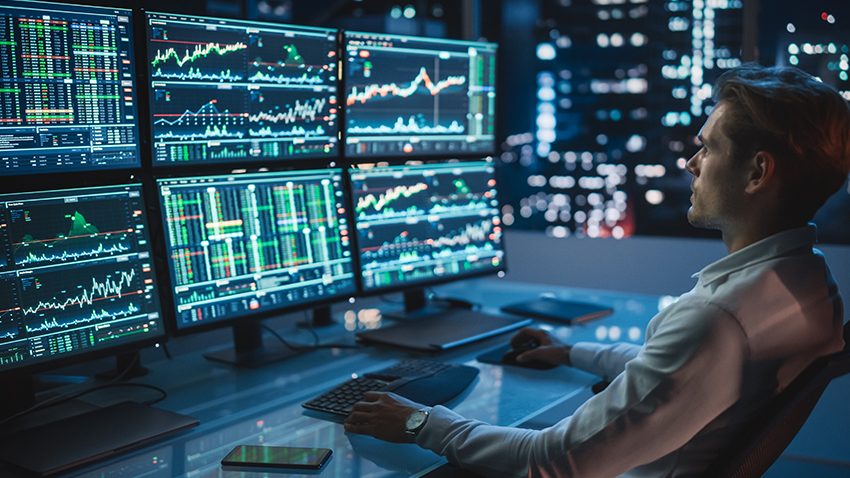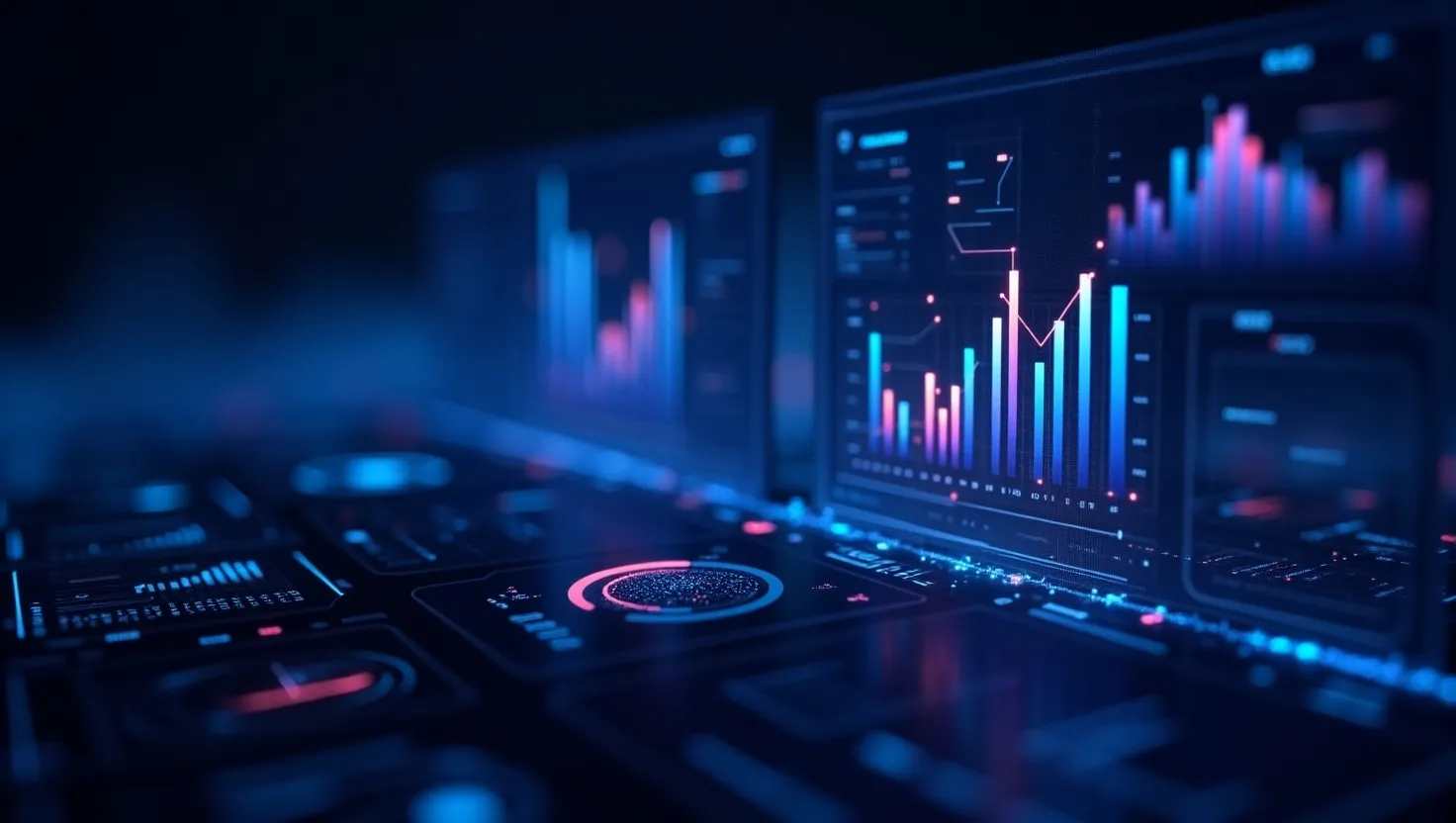
The pace of evolution in the financial market today can best be captured by the efficacy of algorithmic trading technology. Algorithms, plaintext high-frequency trading, and other advanced data analytics have complemented crucial tech stacks that allow let’s say any trader or institution to add speed with high precision in executing that strategy.
There is more to it than just a change in trends; algo trading is now in no uncertain terms a fundamental merging of finance, computer science, and artificial intelligence optimization as far as profit, risk reduction, and predicting market trends are concerned. Whether you are a professional trader, financial institutions, or hobbyist, seeing how high-frequency technology trains the market is paramount so understand the components, applications, and future trends.
Table of Contents
The electronic and algorithmic trading technology environment is vast, covering everything from the fundamental principles, core strategies, technological infrastructures, into the growing role of machine learning and financial algorithms. We get into the algo-trading technology stack, look at trading bots, compare between different market prediction techniques, and determine if really automated trading can make money all the time. Through this exploration, one could understand how algorithmic trading technology shapes conventional markets and what the future promises traders wanting to embrace that innovative approach.
Understanding Algorithmic Trading
Algorithmic trading is also called algo trading or black-box trading. It is a trading method that uses computer algorithms for executing trades automatically depending upon some fixed criteria. The main target is to utilize the power of computation to make the trade much more efficient, lessen the contact of the human factor and respond much faster to market opportunities than could be achieved manually. As markets not only become much more complex but more dependent on data, algorithmic trading technology becomes imperative for traders wanting to remain competitive.
Before technical specifics are discussed, one needs to have an understanding of what algorithmic trading really is and how it’s carried out over the years.
Definition and Overview of Algorithmic Trading
Algorithmic trading is the use of computerized programs that adhere to predetermined rules, geared towards initiating trades smoothly across multiple platforms. The rules are generated from mathematical models, statistical analyses, and market data that allow traders to execute strategies instantaneously in response to changing market conditions.
Algo trading technology specializes in instant analysis and implementation of decisions based on vast amounts of data such as price quotes, order book information, and macroeconomic indicators, thereby processing trade execution orders without human intervention.
Thanks to automation, decisions based on algo-trading technologies provide vastly improved execution speed and low execution cost compared to manual alternatives, along with the implementation of sophisticated trading strategies otherwise impossible to do with human operations.
Customarily, electronic algorithm-trading technologies allow testing strategies on historical data, optimizing parameters, and simulating them to fine-tune performance before application in live markets. This systematic approach dramatically increases the accuracy and consistency of decision-making.
Historical Development and Evolution
As far back in the 1970s, algorithmic trading was already established as electronic systems gradually began to mop out the traditional open outcry trading floors. To begin with, computer algorithms were mainly used to automate benign tasks like order routing and execution. With greater computational power arising during the subsequent decades of the 1980s and 1990s, strategies became increasingly complex, accommodating statistical arbitrage, trend-following models, and market-making algorithms.
In the early 2000s, another landmark occasion occurred in which Internet-based trading platforms opened up the world of basic algo trading to retail traders but institutional players still handled the high-frequency and quantitative strategies. Gradually, the birth of high-frequency trading technology took center stage with ultra-low latency infrastructure, executing thousands of trades in split seconds.
More recently, advances in machine learning, big data analytics, and cloud computing have been further transforming the algorithmic trading technology stack. Today, adaptive algorithms that learn from new data, improve their predictive capabilities, and execute smarter trades essentially challenge and often outperform manual strategies.
Key Components of Algorithmic Trading Systems
Algorithmic Trading Systems comprise several key elements that work together harmoniously to afford a seamless trading experience:
Data acquisition and management: Collecting real-time and historical market data, news feeds, and economic indicators.
Strategy development and backtesting: Designing trading algorithms based on quantitative models and testing their performance against historical data to ensure robustness.
The order execution engine: It handles everything from order placement to routing to execution while minimizing slippage and transaction costs.
Risk management modules: Incorporating stop-loss, take-profit, and position-sizing rules to control exposure.
Monitoring and maintenance: Constantly monitoring its performance, detecting anomalies, and renewing its strategies accordingly.
It is each of this components which pays back the effectiveness, reliability, and compliance of each algorithmic trading operation in respect to the technology.
Types of Algorithmic Trading Strategies
Different trading strategies serve diverse purposes in different market conditions. Here are some unequalled trading strategies listed below:
Trend Following Algorithms
They identify market trends and make trades of purchases when prices increase and short sales during declines. Most use moving averages, MACD, and momentum oscillators as the technical indicators.
Mean Reversion Strategies
These mechanisms take the stance that prices tend to revert to their historical averages. They buy undervalued assets and sell overvalued ones. In most cases, quantitative analysis comes in identifying entry and exit points based on deviations from mean values.
Arbitrage Strategies
The essence of arbitrage is to take advantage of price differences existing among related assets or between markets. One example is in statistical arbitrage where one develops sophisticated models to find mispricements that could be quickly profitably before the market correction.
Market Making and Liquidity Provision
Such a market maker uses trading bots to write ask and bid quotes posting the market making spread and trading focused on managing inventory risk. The high frequency trading technology improves this strategy by allowing rapid quote updating and placement of orders.
The Technology Behind Algorithmic Trading
The successful operation of algorithmic trading is heavily dependent on good technology. A well-structured algo trading tech stack refers to hardware, software, data feeds, and connectivity that enable ultra-low-latency-high-reliability trading environments. As high-frequency trading technology evolves, so do its uses at the highest speed and efficiency.
Understanding the core components of such tech stacks helps traders and institutions design and build optimized systems that can efficiently operate even the most complex strategies.
The Algo Trading Tech Stack
An algo trading tech stack encapsulates layers of hardware, software, and network infrastructure patterned upon the requirements of contemporary trading:
Hardware Layer: High-performance servers, FPGA (Field-Programmable Gate Arrays), and specialized networking units, all built with a focus on low latency.
Software Layer: Trading algorithms, Middleware, APIs, and tools for analysis that use data to trigger trading signals.
Connectivity and Data Feeds: Fast connectivity to the exchanges, co-location services, and reliable data providers for timely market data and order execution.
Risk and Compliance Modules: Automated systems that ensure monitoring of regulations and internal risk limits.
Any efficient algo trading tech stack must be seen in equilibrium so that the performance will be improved while minimizing latency issues by considering hardware capability, software adaptability, and infrastructure costs.
High-Frequency Trading Technology
HFT technology is the greatest emblaze of speed and infrastructural innovation in the realm of automation. Trading microseconds would be a matter of life for HFT firms that would co-locate the traders’ servers with the exchange servers, ultra-low latency networks, and FPGA accelerators to make a trade. The mere objective, really, is to exploit very tiny price moves that recover within milliseconds, thus time is of the essence.
Some of the key characteristics of HFT:
Co-location Services: Placing a trader’s server as close as physically possible to the exchange server minimizes the travel time for its data.
Optimized Infrastructure: Point-to-point microwave or laser communications are utilized to reduce transmission delays.
Truck: Algorithms need to be designed to respond instantaneously to market signals and perform the requisite process.
This technology for high-frequency trading may provide enormous profit potential, but it also raises issues regarding fairness and stability in the market, and as such, regulators from all over the world have begun to take a serious interest in HFT legislation.
Electronic Trading Platforms and Infrastructure
With the present-day electronic trading platforms serving as an interface connecting traders, brokers, and exchanges, the platform offers various advanced features like customizable dashboards, automatic order routing, and real-time analytics.
Infrastructure considerations include:
Reliability and Redundancy of Servers: To guarantee zero downtime with data integrity.
Latency Optimization: Employing colocated servers and direct market access.
Compliance Features: Audit trails, order limits, and monitoring tools are embedded to promote adherence to regulations.
The choice of a platform and the underlying infrastructure highly impact the success rate of algorithmic trading setups, specifically on strategies that require utmost speed and precision.

Data Management and Analysis Tools
At the center of algorithmic trading technology is data. Fast processing of huge datasets, including tick-by-tick prices, order book depth, and macroeconomic indices, allow traders to build complex models.
Some of the key tools include:
Real-Time Data Feeds: Supplying the latest information about markets.
Databases and Storage Solutions: That can securely store and make highly massive amounts of data conveniently available.
Analytical Software: Using statistical packages, Python libraries, or special-purpose platforms for quantitative analysis and visualization.
Advanced analytics enable machine learning models, pattern recognition, and predictive analytics that give support to modern market forecasting techniques.
Applications of Algorithmic Trading Technology
Algorithmic trading technology is used diversely in many areas of financial markets. From routine order execution to machine learning predictive modeling for price forecasting, algorithmic systems act as enablers of efficient and profitable trading.
Let’s take a look at how the different applications apply algo trading technology to re-engineer the very environment.
Automated Trading Systems
Automated trading systems execute buy and sell orders based on pre-programmed algorithms without human intervention. These systems allow for 24-hour operation, in particular, in markets operating outside the normal hours.
Advantages include:
Speed and Efficiency: By rapid decision-making and order execution, such systems obviate delays entailed in manual trading.
Discipline and Consistency: Algorithms stick to the predetermined rules associated with it, thus reducing emotional biases.
Back-Testing and Optimization: Back-testing allows traders to test their strategies against historical data and make any improvements needed before trading live.
In practice, an automated trading setup may involve integrating trading bots with brokerage APIs, while strict risk controls are implemented to sterner limit overexposure or unintended losses.
Use of Financial Algorithms in Market Predictions
Prophetically inclined algorithms process tons of market data for predicting price movements or volatility patterns. Certain techniques such as quantitative analysis help uncover hidden correlations or market inefficiencies. Predictive contexts include:
Statistical Methods– Regression analysis, time series models, and forecasting of volatility.
Machine Learning- Methods include neural networks support vector machines, and the ensemble method which is meant for ever-evolving fine-tuning of predictions.
Sentiment Analysis– Processing news feeds, feeds on social media, macroeconomic reports, etc.: Sentiment step changes in the market.
Such algorithms enable the trader to bet with more accuracy on market direction and to allocate capital strategically.
Quantitative Analysis in Trading Decisions
Quantitative analysis underlies numerous trading schemes put into use by gurus. It entails the mathematical modeling of market behavior, testing of hypotheses, and deriving of actionable signals based on stringent statistical methodologies.
Applications include:
Factor Models: Identifying some factors like the momentum, size, or value that influence an asset’s price.
Portfolio Optimization: Maximizing returns on investment for a given risk using algorithms such as Markowitz’s mean-variance optimization.
Risk-Adjusted Strategies: Taking long or short positions according to volatility measures, drawdown limits, and other risk metrics.
By basing decisions on facts and empirical data, quantitative analysis strengthens the argument and mitigates subjective bias.
Execution Strategies for Optimal Trade Performance
Execution strategies focus on minimizing transaction costs and market impact, ensuring swift execution of trades. Strategies include the subdivision of large orders into several smaller ones, execution at times of highest liquidity, and market making algorithms.
Main Characteristics:
Smart Order Routing: Selection of venues based on best prices and lowest latency.
Adaptive Tactics: A strategy that adjusts dynamically depending on real-time market status.
Liquidity Detection: Locating appropriate timing and venues to execute trades with depth.
Effective execution strategies are the utmost profit-maximizing skill needed, particularly for high-frequency trading activities aimed at capitalizing on small discrepancies in price existing between various markets.
Advantages and Challenges of Algorithmic Trading
In spite of its potential benefits in terms of execution speed and decisions based on data support, algorithmic trading also brings with it an unusual set of challenges such as issues related to risks, regulations, and system complexity. A neutral view is assumed to play a vital role in the approach toward effective implementation.
Benefits of Implementing Algorithmic Trading
Algorithm trading technology comes with many advantages.
This includes greater speed and efficiency: Automation can enable near-instantaneous reaction to market movements, something commonly beyond human traders.
Lower costs: With decreased transaction costs from more efficient order types and minimal slippage.
Quantitative precision: Systematic decision-making based on thorough data analysis minimizes potential for emotional bias and inconsistency.
Market opportunities: Exploiting fleeting arbitrage opportunities and market inefficiencies, which require response capability in milliseconds.
Backtesting and strategy tuning: Improving the prediction and design of strategies by simulating them against historical data.
Therefore, a firm in Vadodara or beyond that invests in algo-trading technologies Vadodara can gain a competitive advantage in the regional and global markets.
Risks Associated with Algorithmic Trading
Algorithmic trading is advantageous, yet it risks that must be effectively managed:
Model risk: Flaws in the algorithm or assumptions are subject to major losses;
Market impact: A large automated trade could cause market dislocation, particularly if it is not calibrated;
Technology failures: System failure, loss of connectivity or bugs in the system might lead to unintended trades or losses;
Regulatory scrutiny: Increasing regulation may impose constraints or penalties for certain high-speed strategies.
Understand and ameliorate all of these risks to achieve sustainable success.
Mitigating Risks Through Effective Risk Management
Implementing risk control measures includes:
Pre-Trade Checks: Limits on position sizes, leverage, and order parameters to prevent catastrophic loss from happening.
Post-Trade Monitoring: Real-time tracking of system performance and trade results.
Stress Testing: Simulation of unfavorable market conditions to test the ability of an algorithm to survive.
Fail-Safe Mechanisms: Circuit breakers, kill switches, and automated shutdown.
When combined, these measures with regular audit would keep algo trading profitable without putting traders at risk.
Regulatory Considerations in Algorithmic Trading
Regulation has a significant influence on algorithmic trading worldwide. Authorities have enforced rules to foster transparency, prevent market manipulation, and ensure fair access.
Things to consider include:
Registration and Reporting: Many jurisdictions require the registration of trading firms and disclosure of trading algorithms to competent authorities.
Market Abuse Prevention: Preventive measures against market abuse and manipulative practices, such as quote stuffing or spoofing.
Order Logic Monitoring: Ensure that the algorithm does not inadvertently break any market rules or generate systemic risks.
Audits and Compliance: Keeping sufficient logging and documentation for regulatory considerations.
Navigating these legal frameworks will be vital, especially for algorithmic trading technologies for Vadodara firms wanting to export their business worldwide.
The Role of Machine Learning in Algorithmic Trading
Machine learning is the next big thing and a game-changing concept in algorithmic trading. It permits the systems to learn from their data, react to the changes in the market, and learn analytic patterns which are quite complex, offering promise for a greater accuracy in output, as well as dynamic responsiveness.
Integrating Machine Learning Techniques
Machine learning and trading utilize algorithms, feature engineering, and validation of the models in which selection plays an important role. SMA includes a stepwise approach where:
Data Preparation: Cleaning and structuring raw market data for training purposes, whereas in
Model Selection: The model is selected depending on whether it is supervised, unsupervised, or reinforcement according to the purpose.
Training and Validation: Models train upon historical data and test their prediction power.
Deployment and Monitoring: In live environments, models will run and continuously retrain with the new data.
Thus, balancing the intricacy of the model against interpretability and robustness shall determine success.
AI-Driven Market Prediction Models
Market Forecasting Models Backed by A.I.
AI-oriented models process multi-dimensioned data from prices, volume, mood, and other macroeconomic indicators to forecast asset price movement. Neural networks bloom into their flowering for the ability to present nonlinear relationships, which are often seen in financial markets.
These models combine themselves well with long short-term memory (LSTM) deep learning architectures to continuously learn from sequential data over time in making predictions, providing a subtle capability in their predictions over time to changes in market pattern.
.
Enhancing Trading Bots with Machine Learning
Trading bots that use machine learning can make quite intelligent decisions, adjusting their strategies based on real-time feedback. These bots can recognize minute signals and adjust execution parameters, even change trading rules on-the-fly.
For instance, reinforcement learning algorithms learn optimal trading policies through trial-and-error interactions with the environment, which continue to improve as they maximize cumulative rewards.
The trader develop bot with this equipment in improving ways to effective deliver smart decisions that provide adjustment to the real-time feedback at any moment. The action can then define or identify subtle signals, provision execution parameters, and adjust further the trading rules that may fit to changing real-time environments.
For example, through reinforcement learning techniques, they learn, from interacting with the environment, how to directly maximize cumulative rewards. They use that experience to improve their performance over time in determining optimal trading policies through trial and error.
Future Trends in Machine Learning and Trading
Therefore, in contrast to supervised learning, a greater focus will be placed on natural language processing (NLP) for news sentiment analysis, on unsupervised learning for anomaly detection, and on explainable AI for transparency. This parallelism in development brings with it the still future possibility of having autonomous and smart AI-driven trading as computational power increases and data sources are diversified.
Exploring the Profitability of Algorithmic Trading
So, does algorithmic trading work? The answer depends on strategy design, technology framework, market conditions, and risk controls. While there were traders that had achieved phenomenal success with respect to algorithmic trading, some others faced difficulties notwithstanding the use of algo trading.
Does Algorithmic Trading Work?
Precision in trade execution and ability in rapid data processing together with adjusting to the market conditions is the phenomenon governing algorithm trading success. Effective, automated systems have demonstrated superiority over discretionary trading methods, especially in highly liquid markets.
If anything, it has shown that success isn’t inherent. There is no guarantee anything will work due to prevailing market conditions and competitiveness. If high-frequency trading offers liquidity provision, technology raised the specter of market fairness and consequently has come under the radar of global regulators.
Can You Make Money with Algorithmic Trading?
Although with promise, the making of money with algorithmic trading results from a well-crafted strategy that requires continuous improvement and disciplined risk management. Profit-making traders implement various strategies, apply quantitative analysis, and run the models constantly to adapt to changing market conditions.
It is important to understand that there is no perfect strategy that always guarantees profits; losses will always occur. Successful algo traders consider losses to be learning opportunities and apply effective risk management strategies to remain profitable in the long term.
Success Stories and Case Studies
Many hedge funds and proprietary trading firms have witnessed great results in algorithm trading. It was said that Renaissance Technologies’ Medallion Fund earned annualized returns of more than 40%, of which the greater part came from advanced financial algorithms and machine learning.
Retail traders can’t say they don’t benefit from trading Bots and auto trading platforms. But still, profitability from its application would be very difficult most times because of the problems within the market and many operational risks involved.
Critical Factors Influencing Profitability
Some primary factors are mentioned as:
Data Quality and Quantity; Richer and accurate datasets make better model training possible. Strategies Robustness: Strategies surviving in different market regimes perform better in the long run. TCP/IP Edge: Better Infrastructure means lesser latency and better execution.
Risk Controls: Effective management avoids catastrophic losses and keeps the capital intact. Finally, continuous learning and adaptation are keys to thriving in the evolution of algo trading.
Conclusion
Algorithmic technology for trading has thoroughly reshaped the entire financial markets, giving rise to such rapid-fire decision making that is rational, importantly, at times even automated.
A fine blend of almost every conceivable algo trading tech stack, from high-frequency trading to sophisticated data analysis to machine learning, now helps traders seize opportunities more efficiently than before. Given the huge profitability potential, another concern is careful strategy development, risk management, and regulatory compliance, which will ultimately decide success or failure.
The ongoing technological evolution foretells even greater innovations for the future of electronic and algorithmic trading technologies, making it an exciting domain for traders and institutions alike who wish to capitalize on automation and intelligent decision making in market participation. Whether researching from Vadodara in the core of India or unleashing their system worldwide, anything you may do while employing any of these tools will offer an upper edge in dynamic marketplaces of today.
FAQS
What is Algorithmic Trading?
Algorithmic trading denotes an automated practice where computer algorithms are deployed for buying and selling of securities. Under given instructions, algorithms execute trades at the best times and prices either on the basis of market data input such as price, volume, or timing.
How do Algorithmic Trading Systems Adjudicate?
Algorithmic trading systems use mathematical models and statistical techniques to interpret data about market prices. They analyze this data to detect potential trading opportunities and act upon them, executing buy and sell orders without any human intervention. Upon the triggering of a trade, the algorithm is set to execute its buy or sell order automatically.
Give the Main Advantages of Algorithmic Trading.
Speed: Orders were executed millisecond fast by the algorithm as compared to humans.
Cost Minimizing: Transaction costs incurred in the execution process get minimized.
Accuracy: Human error is reduced and enhances execution accuracy.
Backtesting: Traders can test their strategies against historical data before implementation.
What Are The Different Types Of Algorithmic Trading Strategies?
Trend following: This is the strategy of determining the trends that are prevalent in the market and following that trend.
Arbitrage: This strategy is the exploitation of price differentials between markets.
Market Making: Buying and selling securities that add liquidity.
Mean reversion: Price will tend to move toward the mean or average.
Statistical arbitrage: Price movements based on the statistical model.
In Algorithmic Trading, Do You Need to Be a Programmer?
Technical knowledge will help but with the increase in complexity of algorithmic trading, most of the modern trading platforms are simple and easy to use, offering pre-developed strategies for the beginner user. Custom strategy decisions, though, would usually require programming knowledge in languages like C++, Python, or R.
What Are The Risks In Algorithmic Trading?
Market Risk: Sudden withdrawals by traders of orders could incur hefty losses.
Technology Failures: Any program freezes or hardware failures can compromise the integrity of an execution.
Overfitting: A tendency of an algorithm to fit historical data too closely may prevent it from functioning well in a live environment.
Liquidity Risk: Liquidity in the market may also be impacted by algorithms under stress in volatile or illiquid scenarios.


Good job 👍 keep it up